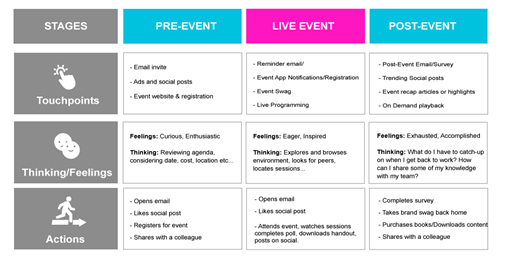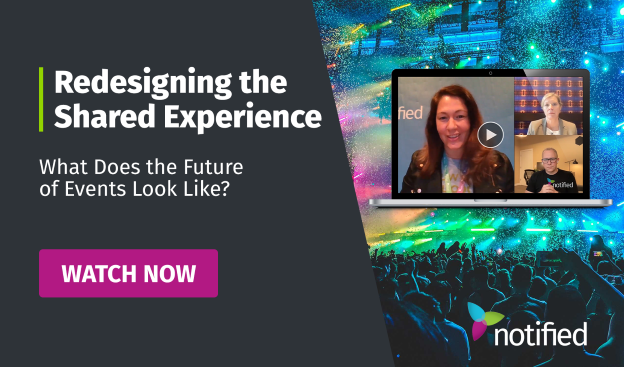According to a recent study by EventBrite, 53% of festival fans say the uniqueness of the event design experience is a key factor in their decision to attend.
Experience-first design allows event planners to get to know attendees on a deeper level, allowing them to develop a creative theme, visual identity, and customer journey for their events that makes the user feel more connected to the brand, the message, and other attendees.
Read on to discover 5 key takeaways from the “Aesthetic Excellence” session at our recent Festival For Communicators and learn how you can create a compelling, immersive experience for your event attendees.
1. Use Empathy to Get to Know Event Attendees
According to the Institute of Design at Stanford, empathy is the foundation of a human-centered design process; by deeply understanding people we are better able to design for them. By really taking the time to get to know your attendee and what is important to them, it shows that you care.
Some questions you should be asking include:
- What motivates your attendees?
- What are their frustrations?
- What are their priorities?
- What is important to your attendees?
These are all questions you should be asking before even beginning to develop your event.
2. Identify Your Event’s End Goals
The next step in planning your online event, is setting your goals. First, ask some questions to identify your goals such as:
- Why are you doing this event?
- What do you want this event to accomplish?
- What changes in behavior should result from the brand and messaging theme?
- How do you want your audience to feel when they leave the event?
- How will you determine if the behavior change is happening?
Second, use these answers to formulate your goals. You may decide to focus on one goal or multiple goals.
Either way, make sure your goal is specific, measurable, achievable, relevant, and timely.
3. Create Specific Event Attendee Personas
After you have taken the time to get to know your audience and set your goals, it’s time to create attendee personas. Not everyone is going to have the same learning style, networking style, and motivations so it’s important to group similar traits rather than have one broad grouping.
Remember, multiple personas, means multiple goals and your event should reflect each individual goal.
A great example of this was the Festival for Communicators Event hosted by Notified. By segmenting the festival into designated tracks for Investor Relations, Public Relations and Events, we created a specific section for each attendee persona that made it feel more personalized.
Some benefits of doing this include:
- Increased retention
- Personalized event experience
- Diversification
- Refined marketing messaging
- Understanding motivation
4. Use Event Journey Mapping

Arguably, one of the most important steps for ensuring your event experience is unique, is journey mapping.
Journey mapping allows you to pinpoint touch points, feeling, and actions throughout the stages of your event to identify opportunities for attendee interaction. This can help you understand where your gaps are, visualize your schedule and ensure a lasting impression for your audience.
Remember, you should be identifying a different journey for each persona you created in the last step.
5. Design for All 5 Senses
A common mistake is that event planners tend to focus on the look of the event rather than the feel. It is so important to think beyond just the visuals to create a multi-sensory brand experience.
Touch/Feel
A great idea to incorporate into your next event is to find a partner or sponsor that can provide a service. One virtual event partnered with the Calm Meditation app to do breathing exercises in between event sessions to keep their audience engaged, let them relax after an information packed session, and allow them to feel connected to the event itself.
Sight
While the look of the event is very important, every other sense is just as important in creating an engaging virtual event as well. Create your attendee persona and create a visually stunning event that fits your audience’s needs.
Smell
Whether you are sending food, drinks, or a gift box to your attendee’s house, make sure you’re adding something that will make them associate a certain smell with your brand. It can be anything from a scented Chapstick to a little essential oil, you don’t want to leave this sense out!
Hear
Test, test, test. Make sure in the days leading up to your event that you have tested and worked out every flaw in the online environment. Make sure the audio is clear and all your presenters are speaking clearly, at a reasonable volume, and are engaging when they speak or tell a story.
Taste
Have fun with this one. Doordash is a great resource that allows you to give attendees a budget for lunch or dinner and provides them with the option to order food from 390,000+ restaurants. This is a great way to fuel your virtual events and bring everyone together with food delivered right to their homes.
Watch Our On-Demand Session
Want to learn even more? Check out this on-demand content we think you'll love!
Watch our expert panel of meeting professionals as they share their vision for Redesigning the Shared Experience and what that will mean for the future of events.

